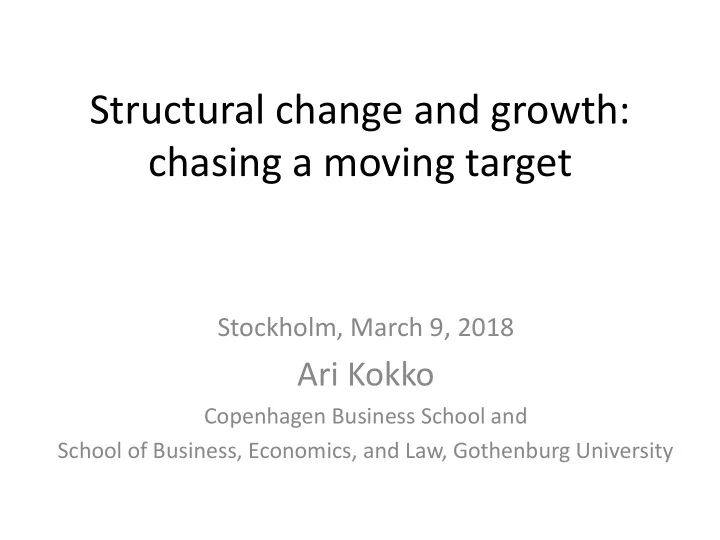

Structural change and growth: chasing a moving target Stockholm, March 9, 2018 Ari Kokko Copenhagen Business School and School of Business, Economics, and Law, Gothenburg University
Introduction • Many fields of research have studied structural change and transformation – My entry points: development economics and international economics – Others have chosen other entry points: economic geography, macroeconomics, growth theory, innovation, technology policy, labor etc etc • Multiple objectives: to understand processes in order to identify impacts and to influence patterns of development • Today’s talk: how has my understanding of structural transformation and its policy space changed over time?
Starting point • Development economics – Development is structural change. Need to support transformation from primary to secondary and tertiary sectors with higher value added and better growth prospects • International economics – International trade and FDI change economic structure. Specialization according to comparative advantages transforms economies
Illustration: The Lewis Turning Point
Illustration: International Trade
Illustration: Impact of FDI Akamatsu’s Flying Geese Model
Consequences and policies • Trade and FDI beneficial for all parties involved in the game – Although some will benefit more than others • “Simple” policy prescriptions – Investment, urbanization, and trade policy to promote development (with mix of import substitution and export orientation depending on preferences) – Trade policy and classical industrial policy to influence patterns of export competitiveness – Openness to FDI, both inward and outward
However, global value chains change the game. Industries may stay even if activities move.
Industries stay but activities move New Version Structural Transformation in Japan Main industries Time Japan Japan Japan Japan Japan 1950s 1960s 1970s 1980s 1990s
When value chains are deconstructed • Continuous reconfiguration of activities within enterprises and industries – Specialization and servicification – Outsourcing and offshoring – Shift in focus from individual industry or product category to value chains, clusters, and development blocks • Standard indicators of economic structure may miss out on change processes – Example: Swedish MNCs
Illustration: Changes in the population of plants owned by Swedish MNCs 1986-1994 Fors & Kokko (2000)
Shift in focus from industry to activity • What activities are kept at home? Where do we really have our current comparative advantages? – Look at skills, capabilities, competencies • Why does it matter? – Quality of current jobs, but also the quality of what we will get tomorrow – Relatedness – Regional differences within national economies: skills, capabilities, and competencies are not evenly distributed • What is the scope of policy (and policy assessment)? – Focus on skills, capabilities, competencies – Regional dimensions – Coordination and complementarities
Illustration: Development of local labor markets in Sweden 1985-2014 (employment) Henning et al. (2016)
Employment growth across “skill” categories, Sweden 2008-2013 Medellång Lång Grundskola Kort eftergymnasial eftergymnasial eftergymnasial Henning et al. (2016)
Risk and resilience : The impact of automation on labor market groups Högskole- Bygg- Kortare Service, kompetens omsorg, verksamhet utbildning, Chefsyrken försäljning introduktion Lantbruk, Tillverkning, skogsbruk, Admin/ Fördjupad transport fiske kundtjänst högskoleutb Henning et al. (2016)
Links between resilience and employment growth, local labor markets in Sweden, 2001-2013 Henning et al. (2016)
Relatedness • Where we are today matters for where we can go / what we can do in the future • Ricardo Hausmann, Cesar Hidalgo et al (Harvard, MIT) – Product Space. Products are connected if they use the same broad set of assets and are co-exported. Countries move from one set of products to the next in a predictable manner. • Martin Henning et al (U of Gothenburg) – Skill-relatedness . Industries are related if they use similar skills and capabilities. Skill-relatedness facilitates diversification and expansion into related industries/activities
The Product Space C. A. Hidalgo et al. Science 2007;317:482-487
Industry space , Sverige, 2008-2011 Henning (2014)
Units of analysis changing over time Time Skills, Capabilities Individuals National / Regional Champions Firms Clusters, Value Chains, Strategic / Dynamic Development Blocks Industries Industries Agriculture to Sectors Industry
Policy instruments changing over time Education policy, regional policy, Time incentives ++ S&T policy, Individuals trade & FDI policy, competition policy, procurement, subsidies Firms Trade policy, S&T policy, education, classical Industries regional policy, Industrial policy policy coordination Trade policy, institutions urbanization, Sectors education, institutions
Thought experiment • What if the main drivers of change in the coming decade are – Big Data – Artificial Intelligence – Digitalization / Automation / Robotization? • What is needed for successful adjustment? At what level should interventions be made? – Change in industry structure? • Increased production of hardware (computers, robots)? – Investment in physical capital? • More computing power)? – Investment in human capital / skills? • To develop technologies / solutions • To apply technologies
Policy assessment • Focus on individuals may simplify policy assessment – Performance of education institutions • Higher education • Life-long learning – Formal qualifications of the labor force – Employment development – Income • But policy making may become more difficult – Regional dimension challenges national policy – Substantial time lags between policy intervention and outcomes – Analytical capability / foresight more important – Hard to see quick fixes
Selected references M. Henning, J. Boström Elias, J. Jakobsson och F. M. Henning, (2014), Branschöverskridande M. Henning, J. Borggren, J.Boström Elias, K. Lavén (2017), Kompetenslandskapets kompetensknippen – Nya perspektiv på Enflo, F. Lavén (2016), Strukturomvandling och omvandling mot industri 4.0 - Långsiktiga Västsveriges näringslivsstruktur, Västra automatisering – Konsekvenser på regionala perspektiv på kompetensbehovet inom industri Götalandsregionen och Region Halland. arbetsmarknader, Västra Götalandsregionen och och industrinära tjänster i Västra Götaland, CRA Region Skåne. Working Paper Nr 2017:1, Handelshögskolan, Göteborgs Universitet.
Recommend
More recommend